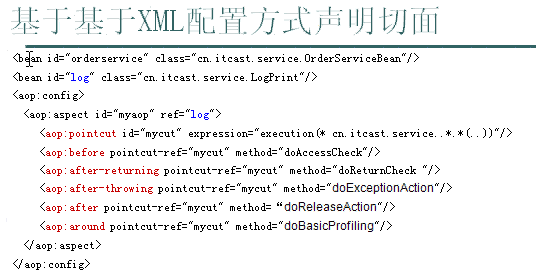spring aop的使用(注解方式以及基于xml配置方式)
2012-08-06 15:28
1266 查看
注解方式
*******************
beans.xml
*******************
***************
MyInterceptor.java
***************
***************
PersonService.java
***************
***************
PersonServiceBean.java
***************
***************
SpringAOPTest.java
***************
***************
运行结果
***************

基于xml配置方式

*************
beans.xml
************
*******************
MyInterceptor.java
*******************
aop表达式的使用方法
<aop:pointcut id="point" expression="execution (!void blog.service.impl.PersonServiceBean.*(..))"/>
!void blog.service.impl.PersonServiceBean.*(..)中!void 表示拦截所有返回类型为非void类型的方法
java.lang.String表示拦截所有返回类型为String类型的方法
* blog.service.impl.PersonServiceBean.*(java.lang.String,..)表示拦截所有第一个参数为String类型的方法
*******************
beans.xml
*******************
<?xml version="1.0" encoding="UTF-8"?> <beans xmlns="http://www.springframework.org/schema/beans" xmlns:xsi="http://www.w3.org/2001/XMLSchema-instance" xmlns:context="http://www.springframework.org/schema/context" xmlns:aop="http://www.springframework.org/schema/aop" xsi:schemaLocation=" http://www.springframework.org/schema/beans http://www.springframework.org/schema/beans/spring-beans-2.5.xsd http://www.springframework.org/schema/context http://www.springframework.org/schema/context/spring-context-2.5.xsd http://www.springframework.org/schema/aop http://www.springframework.org/schema/aop/spring-aop-2.5.xsd "> <aop:aspectj-autoproxy/> <bean id="myInterceptor" class="blog.service.MyInterceptor"/> <bean id="personService" class="blog.service.impl.PersonServiceBean"></bean> </beans>
***************
MyInterceptor.java
***************
package blog.service;
import org.aspectj.lang.ProceedingJoinPoint;
import org.aspectj.lang.annotation.After;
import org.aspectj.lang.annotation.AfterReturning;
import org.aspectj.lang.annotation.AfterThrowing;
import org.aspectj.lang.annotation.Around;
import org.aspectj.lang.annotation.Aspect;
import org.aspectj.lang.annotation.Before;
import org.aspectj.lang.annotation.Pointcut;
/**
* 切面
*
*/
@Aspect
public class MyInterceptor {
@Pointcut("execution (* blog.service.impl.PersonServiceBean.*(..))")
public void anyMethod() {
//表达式解释:* blog.service.impl.PersonServiceBean.*(..):第一个*号表示返回类型;
//blog.service.impl.PersonServiceBean.*:表示PersonServiceBean类下的所有方法
//blog.service.impl..*.*:表示blog.service.impl包及其子包下的所有类的所有方法
//(..):表示所有的参数类型几个数都不限
}// 声明一个切入点
//会拦截参数签名位 (String , int)或(String , Integer )类型的方法,
//参数顺序与args(uname,id)一致,参数类型由(int id,String uname)决定
@Before("anyMethod() && args(uname,id)")
public void doAccessCheck(int id,String uname) {
System.out.println("前置通知:" + uname + id);
}
@AfterReturning(pointcut="anyMethod()",returning="result")
public void doAfterReturning(String result) {
System.out.println("后置通知:" + result);
}
@After("anyMethod()")
public void doAfter() {
System.out.println("最终通知");
}
@AfterThrowing(pointcut="anyMethod()",throwing="e")
public void doAfterThrowing(Exception e) {
System.out.println("例外通知:" + e.getMessage());
}
@Around("anyMethod()")
public Object doBasicProfiling(ProceedingJoinPoint pjp) throws Throwable{
//if(){//判断用户是否有权限
System.out.println("进入方法");
Object result = pjp.proceed();
System.out.println("退出方法");
//}
return result;
}
}***************
PersonService.java
***************
package blog.service;
public interface PersonService {
public String save(String name);
public String update(String name,Integer userId);
public String delete(int id,String dept);
}***************
PersonServiceBean.java
***************
package blog.service.impl;
import blog.service.PersonService;
public class PersonServiceBean implements PersonService {
private String username = null;
public String getUsername() {
return username;
}
public PersonServiceBean() {
}
public PersonServiceBean(String username) {
this.username = username;
}
@Override
public String save(String name) {
if (name.equals("") || name == null) {
throw new RuntimeException("出错啦");
}
System.out.println("in save method!" + name);
return "in save method!" + name;
}
@Override
public String update(String name, Integer userId) {
System.out.println("in update method! name = " + name + " id = "
+ userId + " username = " + username);
return "in update method!name = " + name + " id = " + userId;
}
@Override
public String delete(int id, String dept) {
System.out.println("id = " + id + " dept = " + dept);
return "in delete method! + nameid = " + id + " dept = " + dept;
}
}***************
SpringAOPTest.java
***************
package junitTest;
import org.junit.BeforeClass;
import org.junit.Test;
import org.springframework.context.ApplicationContext;
import org.springframework.context.support.ClassPathXmlApplicationContext;
import blog.service.PersonService;
public class SpringAOPTest {
@BeforeClass
public static void setUpBeforeClass() throws Exception {
}
@Test
public void AopTest(){
ApplicationContext ctx = new ClassPathXmlApplicationContext("beans.xml");
PersonService service = (PersonService)ctx.getBean("personService");
try {
service.delete(12, "it");
service.update("发多个地方",324);
service.save("");
} catch (Exception e) {
e.printStackTrace();
}
}
}***************
运行结果
***************

基于xml配置方式

*************
beans.xml
************
<?xml version="1.0" encoding="UTF-8"?> <beans xmlns="http://www.springframework.org/schema/beans" xmlns:xsi="http://www.w3.org/2001/XMLSchema-instance" xmlns:context="http://www.springframework.org/schema/context" xmlns:aop="http://www.springframework.org/schema/aop" xsi:schemaLocation=" http://www.springframework.org/schema/beans http://www.springframework.org/schema/beans/spring-beans-2.5.xsd http://www.springframework.org/schema/context http://www.springframework.org/schema/context/spring-context-2.5.xsd http://www.springframework.org/schema/aop http://www.springframework.org/schema/aop/spring-aop-2.5.xsd "> <aop:aspectj-autoproxy/> <bean id="myInterceptor" class="blog.service.MyInterceptor"/> <bean id="personService" class="blog.service.impl.PersonServiceBean"></bean> <aop:config> <aop:aspect id="aspectBean" ref="myInterceptor" > <aop:pointcut id="point" expression="execution (!void blog.service.impl.PersonServiceBean.*(..))"/> <aop:before method="doAccessCheck" pointcut-ref="point" /> <aop:after-returning method="doAfterReturning" pointcut-ref="point" /> <aop:after-throwing method="doAfterThrowing" pointcut-ref="point"/> <aop:after method="doAfter" pointcut-ref="point"/> <aop:around method="doBasicProfiling" pointcut-ref="point" /> </aop:aspect> </aop:config> </beans>
*******************
MyInterceptor.java
*******************
package blog.service;
import org.aspectj.lang.ProceedingJoinPoint;
public class MyInterceptor {
public void anyMethod() {
}
public void doAccessCheck() {
System.out.println("前置通知" );
}
public void doAfterReturning() {
System.out.println("后置通知");
}
public void doAfter() {
System.out.println("最终通知");
}
public void doAfterThrowing() {
System.out.println("例外通知");
}
public Object doBasicProfiling(ProceedingJoinPoint pjp) throws Throwable{
//if(){//判断用户是否有权限
System.out.println("进入方法");
Object result = pjp.proceed();
System.out.println("退出方法");
//}
return result;
}
}aop表达式的使用方法
<aop:pointcut id="point" expression="execution (!void blog.service.impl.PersonServiceBean.*(..))"/>
!void blog.service.impl.PersonServiceBean.*(..)中!void 表示拦截所有返回类型为非void类型的方法
java.lang.String表示拦截所有返回类型为String类型的方法
* blog.service.impl.PersonServiceBean.*(java.lang.String,..)表示拦截所有第一个参数为String类型的方法
相关文章推荐
- spring aop的使用(注解方式以及基于xml配置方式)
- spring aop的使用(注解方式以及基于xml配置方式)
- 8 -- 深入使用Spring -- 4...6 AOP代理:基于注解的XML配置文件的管理方式
- 8 -- 深入使用Spring -- 4...5 AOP代理:基于注解的“零配置”方式
- spring之aop编程——基于注解、xml配置文件方式
- Spring AOP基于注解的“零配置”方式实现以及一些其他知识点
- 基于spring注解方式配置和使用spring AOP
- Spring 3.0.5 MVC 基于注解ehcache.xml 配置方式
- Spring学习一:IOC(控制反转)和AOP(面向切面)的xml配置和注解方式
- 基于注解的Spring AOP的配置和使用--转载
- 实例说明Spring实现AOP的2种方式(注解和XML配置)
- 使用Spring的配置xml方式实现AOP
- Spring中基于配置XML与Annotation注解配置AOP
- 基于注解的Spring AOP的配置和使用
- 基于注解的Spring AOP的配置和使用--转载
- 重温Spring之旅6——基于XML配置方式进行AOP开发
- Spring 基于XML配置 基于注解配置 基于JAVA类配置比较以及适用场景
- Spring实现AOP方式之二:使用注解配置 Spring AOP
- (9) 使用Spring的注解方式实现AOP入门 以及 细节
- 基于注解的Spring AOP的配置和使用--转载
